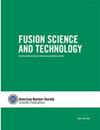Study on Tritium Permeation from the Primary to the Secondary Water Coolant for Fusion Reactors
IF 1.2
4区 工程技术
Q3 NUCLEAR SCIENCE & TECHNOLOGY
引用次数: 0
Abstract
AbstractSeveral fusion plants plan to utilize two high-temperature and high-pressurized water coolant systems. Because of the high hydrogen-isotope mobility in high-temperature metal, tritium will inevitably transfer from the plasma side to the secondary coolant through the primary coolant. From the viewpoints of fuel control, tritium safety, and social acceptance, it is compulsory to investigate the tritium concentration dependence of permeation phenomena experimentally. Therefore, this study conducted a protium permeation experiment instead of tritium, which mocked the situation where the tritium concentration in the primary loop was extremely high. Considering the results in the previous tritium permeation research by the present authors, the tritium permeation behavior was likely proportional to the first power of the tritium concentration. Then, based on these experiments and references regarding the tritium permeation rate and water detritiation system (WDS) design, tritium concentration was computed in both loops. In this calculation condition, the primary and secondary loops reached about 0.4 TBq/kg and 167 MBq/kg during 3-year operations, respectively. Also, it was found that the required feed rate to keep the tritium concentration at 1 TBq/kg was 46.5 kg/h, which is less than the existing WDS specification.Keywords: Tritium permeationprotium permeationwater to waterInconel 600water detritiation system Disclosure StatementNo potential conflict of interest was reported by the author(s).Additional informationFundingThis work was supported by QST Research Collaboration for Fusion DEMO, JSPS KAKENHI Grant-in-Aid for Scientific Research (B) [JP22H01207], and JST SPRING, Grant Number [JPMJSP2136].核聚变反应堆主水冷剂向二次水冷剂氚渗透的研究
一些核聚变厂计划采用两种高温高压水冷却剂系统。由于高温金属中氢同位素的高迁移率,氚将不可避免地从等离子体侧通过一次冷却剂转移到二次冷却剂。从燃料控制、氚安全性和社会接受的角度出发,对氚浓度对渗透现象的依赖性进行实验研究是必要的。因此,本研究采用protium渗透实验代替tritium,模拟了初级回路中氚浓度极高的情况。考虑到本作者之前的氚渗透研究结果,氚的渗透行为可能与氚浓度的一次方成正比。然后,根据这些实验和参考文献,对氚的渗透速率和水降解系统(WDS)设计进行了计算,计算了两个回路的氚浓度。在此计算条件下,3年运行期间,主回路和次回路分别达到约0.4 TBq/kg和167 MBq/kg。同时,将氚浓度保持在1 TBq/kg所需的进料速率为46.5 kg/h,低于现有的WDS规格。关键词:氚渗透;protium渗透;水对水;本工作由QST聚变演示研究合作、JSPS KAKENHI科学研究资助(B) [JP22H01207]和JST SPRING资助号[JPMJSP2136]支持。
本文章由计算机程序翻译,如有差异,请以英文原文为准。
求助全文
约1分钟内获得全文
求助全文
来源期刊

Fusion Science and Technology
工程技术-核科学技术
CiteScore
2.00
自引率
11.10%
发文量
60
审稿时长
3 months
期刊介绍:
Fusion Science and Technology, a research journal of the American Nuclear Society, publishes original research and review papers on fusion plasma physics and plasma engineering, fusion nuclear technology and materials science, fusion plasma enabling science technology, fusion applications, and fusion design and systems studies.
 求助内容:
求助内容: 应助结果提醒方式:
应助结果提醒方式:


